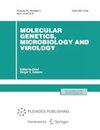大鼠中隔成形术后海马中p53蛋白表达及暗神经元的变化
IF 0.3
4区 生物学
Q4 BIOCHEMISTRY & MOLECULAR BIOLOGY
引用次数: 2
摘要
本研究评估了大鼠中隔成形术实验模型中p53蛋白表达对海马暗神经元(dn)发生的依赖性。对15只性成熟雄性Wistar大鼠进行鼻中隔成形术模拟实验。我们用尼氏甲苯胺蓝和p53蛋白抗体染色海马组织切片。CA1亚区p53阳性神经元数量在第2天、第4天和第6天显著增加(p < 0.001)。动态评估发现CA1和CA2神经元细胞质中p53蛋白表达在术后第2 ~ 4天达到峰值,而这些神经元数量在术后第6天减少(p < 0.001)。术后各时期CA3神经元细胞质中p53蛋白表达均较对照组升高。CA1锥体层的DNs数量在第6天减少(p < 0.001)。2天后,与第4天相比,CA2中的DNs数量最少(p < 0.001)。在CA3中,第4天的DNs数量与其他天相比达到高峰(p < 0.001)。在评估的所有时期和海马的所有子区中,暗神经元和p53阳性神经元数量的增加之间存在很强的正相关。大鼠中隔成形术后海马形成暗神经元和p53阳性神经元的出现是神经组织对应激的典型反应。可见,p53蛋白的表达与神经细胞质的嗜碱性和神经元的形态功能状态有关。据推测,p53蛋白不仅可以触发海马体中受损神经元的激活,还可以发挥神经保护作用。未来的研究应确定p53蛋白在锥体层受损神经元的进一步命运中的作用,并分化其表达机制。本文章由计算机程序翻译,如有差异,请以英文原文为准。
Protein p53 Expression and Dark Neurons in Rat Hippocampus after Experimental Septoplasty Simulation
This study evaluated the dependence of p53 protein expression on the occurrence of dark neurons (DNs) in the hippocampus of rats during experimental modeling of septoplasty. Septoplasty simulation was carried out on 15 sexually mature male Wistar rats. We studied histological sections of the hippocampus stained with Nissl toluidine blue and antibodies to p53 protein. In the CA1 subfield, the number of p53-positive neurons significantly increased on the second, fourth ( p < 0.001), and sixth days ( p < 0.05). Dynamic assessment detected the peak of p53 protein expression in the cytoplasm of CA1 and CA2 neurons from the second to fourth days after surgery, while the number of these neurons decreased on the sixth day ( p < 0.001). In the cytoplasm of CA3 neurons at all periods after surgery, the expression of p53 protein increased compared to the control group. In the CA1 pyramidal layer, the number of DNs decreased on the sixth day ( p < 0.001). After 2 days, the minimal number of DNs was noted in CA2 compared with the fourth day ( p < 0.001). In CA3, there was a peak in number of DNs on the fourth day compared with the other days ( p < 0.001). A strong positive correlation was found at all periods of assessment and in all subfields of the hippocampus between the increase in the number of dark and p53-positive neurons. The occurrence of dark and p53-positive neurons in the hippocampal formation of rats after septoplasty modeling is a typical response of nervous tissue to stress. It is obvious that the expression of p53 protein is associated with basophilia of neural cytoplasm and the morphofunctional state of neurons. Presumably, the p53 protein can trigger not only the activation of damaged neurons in the hippocampus, but can also play a neuroprotective role. Upcoming studies should determine the role of p53 protein in further fate of damaged neurons in the pyramidal layer and differentiate the mechanisms of its expression.
求助全文
通过发布文献求助,成功后即可免费获取论文全文。
去求助
来源期刊

Molecular Genetics, Microbiology and Virology
BIOCHEMISTRY & MOLECULAR BIOLOGY-MICROBIOLOGY
CiteScore
0.70
自引率
0.00%
发文量
8
审稿时长
>12 weeks
期刊介绍:
Molecular Genetics, Microbiology and Virology is a journal that covers most topical theoretical and applied problems of molecular genetics of pro- and eukaryotic organisms, molecular microbiology and molecular virology. An important part the journal assigns to investigations of the genetic apparatus of microorganisms, searching for forms of genetic exchange, genetic mapping of pathogenic causative agents, to ascertainment of the structure and functions of extrachromosomal factors of heredity and migratory genetic elements, to theoretical studies into the mechanisms of genetic regulation. The journal publishes results of research on molecular and genetic bases of an eukaryotic cell, functioning of chromosomes and chromatin, nature of genetic changes in malignization and a set of hereditary diseases. On the pages of the journal there is covered the formulation of molecular bases of virology including issues of integration of viral and cellular genomes, and issues of persistence. The journal plans to put materials on genetic engineering, envisaging synthesis and isolation of genes from natural reservoirs, creation of plasmid- and virus-based vector, production of recombinant DNA molecules, the creation of Gene Banks for Microbes, animals, and human; and also on biotechnological production of hormones, components of antiviral vaccines, diagnostic and therapeutic preparations.
 求助内容:
求助内容: 应助结果提醒方式:
应助结果提醒方式:


